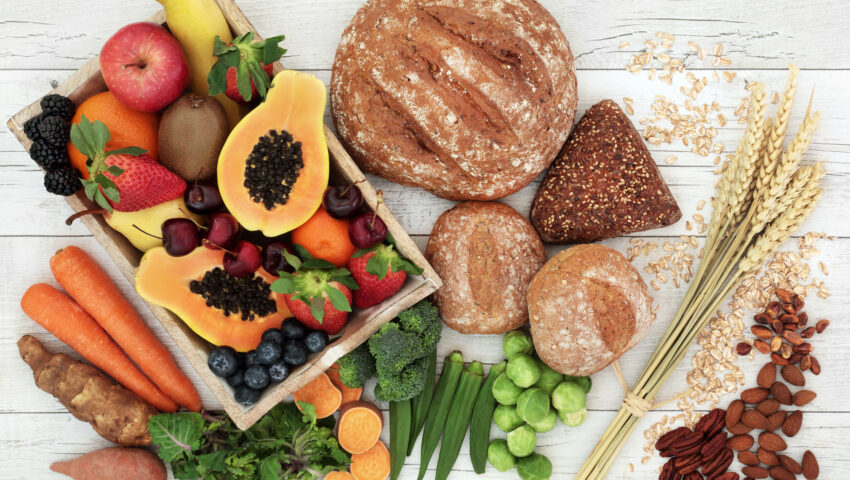Blogs
What is fibre?

On this month’s blog we are going to explore the significance of fibre in our daily diet and provide you with practical tips on how to incorporate more fibre-rich foods into your meals.
What is Fibre?
It is an essential nutrient that plays a vital role in our digestive health, cholesterol regulation, and blood sugar control. Unlike other carbohydrates, fibre is only found in plant-based foods and is not entirely absorbed or digested by our bodies.
There are two main types of fibre:
- Soluble Fibre:
Dissolves in water and forms a gel-like substance that aids in lowering cholesterol levels and regulating blood sugar. Excellent sources of soluble fibre include oats, whole grains, peas, beans, apples, and citrus fruits.
- Insoluble Fibre:
Does not dissolve in water but acts as a bulking agent, promoting a healthy digestive system. Nuts, beans, vegetables, and potatoes are great sources of insoluble fibre.
The Benefits of Fibre:
Now you might be wondering, if our bodies don’t absorb or digest fibre, why do we need it in our diet? Let’s explore some of the incredible benefits it provides:
- Aids Digestion: Keeps our digestive system running smoothly, preventing constipation, and helping eliminate waste products efficiently.
- Weight Management: While it isn’t a magical weight-loss tool, it can help us feel fuller for longer. By expanding in the digestive system, it reduces the amount of food we consume, especially energy-dense options, potentially aiding in maintaining a healthy weight.
- Blood Sugar Regulation: A high-fibre diet, rich in wholesome foods, is associated with reducing the risk of insulin resistance and type 2 diabetes, as well as helping to maintain stable blood glucose levels.
- Gut Microbiome Support: Acts as fuel for the friendly bacteria in our gut, contributing to a healthy gut microbiome, which plays a significant role in overall health and well-being.
The Fibre Gap: Despite the numerous benefits, studies show that most adults are falling short of meeting the recommended daily intake.
In the UK, the average consumption is only 18g per day, whereas the recommendation is 30g.
The rise of processed and ultra-processed foods, coupled with a lower intake of whole foods like fruits and vegetables, contributes to this gap.
Practical Tips for Boosting Your Fibre Intake:
1. Start with a Fibre-Rich Breakfast
Kickstart your day with a high-fibre breakfast, such as a bowl of oatmeal topped with nuts, seeds, and berries, or enjoy whole-grain toast with avocado and a boiled egg.
2. Choose Whole Grains
Opt for whole-grain options instead of refined grains when selecting bread, pasta, and rice. Look for labels that list whole wheat, whole rye, or whole grain as the first ingredient.
3. Snack on Fibre-Rich Foods
Fruits, vegetables, and nuts make fantastic snacks. Keep a bowl of fruit on your desk or pack carrots and hummus for a satisfying mid-afternoon treat. Don’t forget the handful of nuts, which provide both fibre and healthy fats.
4. Bulk up Your Bakes
Treat your taste buds without sacrificing nutrition by adding fibre-rich ingredients like fruits, vegetables, nuts, seeds, oats, and whole-grain flour to your baking recipes.
5. Explore Whole-Grain Recipes
Get creative in the kitchen by experimenting with delicious whole-grain recipes. Try a quinoa salad, a brown rice stir-fry, or a whole-wheat pasta dish to explore the world of whole grains.
Monthly Challenge
As we wrap up this article, we challenge you to incorporate one or two of these tips into your daily or weekly routine.
Remember to gradually increase your fibre intake and drink plenty of water to prevent any digestive discomfort. By prioritizing fiber in your diet, you can enhance your digestive health, regulate cholesterol, and blood sugar levels, and foster a flourishing gut microbiome.
Further reading recommendations:
https://www.bda.uk.com/resource/fibre.html
https://www.nhs.uk/live-well/eat-well/digestive-health/how-to-get-more-fibre-into-your-diet/
Listen to more soundbites from Charlotte here




